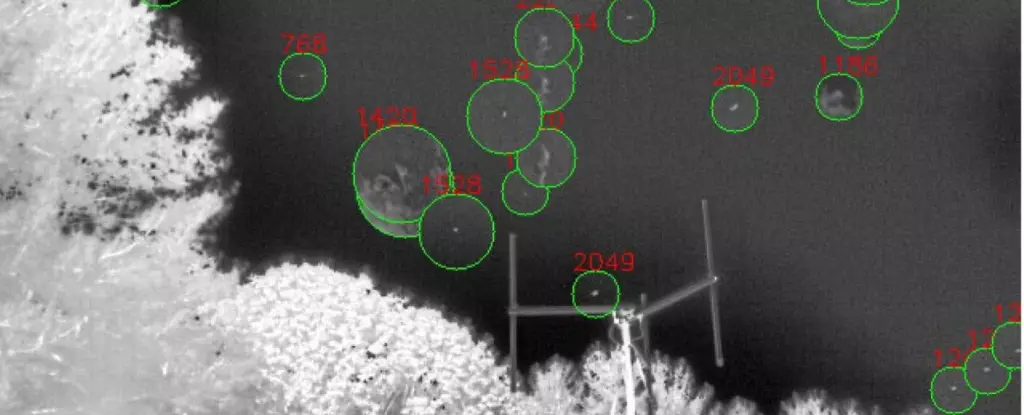In an age marked by technological advancement and the relentless pursuit of knowledge, the exploration of unidentified aerial phenomena (UAP) has gained unprecedented interest. The recent wave of disclosures from the Office of the Director of National Intelligence (ODNI) and subsequent reports from the Department of Defense through the All-domain Anomaly Resolution Office (AARO) have opened a Pandora’s box of questions regarding the existence of extraterrestrial life. Despite the governmental advancements, however, there remains a glaring void in publicly accessible scientific data. This is where innovative initiatives from institutions like the Harvard-Smithsonian Center for Astrophysics (CfA) and the Galileo Project come into play, as they endeavor to bridge the gap between speculation and empirical evidence.
Challenging Traditional Approaches with New Technology
A recent proposal introduced by Laura Domine and her team suggests the use of a sophisticated All-Sky Infrared Camera, aptly nicknamed “Dalek”—a nod to the iconic antagonists in the Doctor Who series. This ingenious device is poised to enhance our observational capabilities, pushing the limits of our understanding regarding UAPs and their potential correlation with extraterrestrial spacecraft. Domine’s involvement, as a prominent Keto-Galileo Postdoctoral Fellow at Harvard, signals the integration of innovative research methodologies that challenge traditional scientific paradigms.
The project’s relevance is amplified by NASA’s endorsement of rapidly adaptive, purpose-built sensors that can respond to unidentified phenomena in real-time. This recommendation echoes the growing consensus in the scientific community that a multifaceted approach to UAP detection is essential. Rather than relying solely on a singular type of sensor, an array of technologies—including infrared, optical, radio, and audio modalities—can yield a more comprehensive understanding of these enigmatic occurrences.
Data Collection and Analysis: A Groundbreaking Initiative
At the heart of this paradigm shift lies the Galileo Project’s ambitious initiative to systematically catalog aerial phenomena through multiple observatories in the United States, with the primary one established at Harvard University. With each observatory reportedly detecting around 100,000 objects per month, the project has amassed an extensive database exceeding one million observations. Utilizing advanced machine learning techniques, including the You Only Look Once (YOLO) object detection model and the Simple Online and Real-time Tracking (SORT) algorithm, researchers can sift through vast amounts of data to isolate anomalous objects that defy classification.
The initial findings from the observatories’ first five months of operation are nothing short of staggering. The identification of approximately 500,000 objects, with 80,000 flagged as outliers due to their unconventional characteristics, indicates a fruitful beginning in spotting potential technosignatures—indicators of advanced technological societies beyond Earth. This proactive approach contrasts sharply with classified governmental assessments, wherein only a mere 3% of cases remain ambiguous. The Galileo Project’s methodology promotes transparency and collaboration in an arena often characterized by secrecy, enhancing public curiosity and scientific integrity.
The Role of Transparency in Scientific Discovery
Professor Avi Loeb, at the helm of the Galileo Project, emphasizes the dichotomy between classified government data and the open-source approach underpinning their research. “The sky is not classified,” Loeb asserts, reinforcing the imperative for unimpeded access to observational data. Such transparency fosters public engagement and accountability while invigorating scientific inquiry.
As the initiative continues, the prospect of triangulating distances using multiple sensors within each observatory hints at future breakthroughs in understanding the velocities and movements of suspected UAPs. This level of precision is pivotal for discerning between mundane occurrences—such as drones or weather balloons—and genuinely anomalous objects. The implication is that should even a single UAP exhibit behavior beyond the scope of current human technology, it would revolutionize our collective understanding of life in the universe.
As researchers delve deeper into the mysteries of the cosmos, initiatives like the Galileo Project exemplify a bold leap forward in the quest for extraterrestrial evidence. By blending cutting-edge technology with a commitment to transparency, the scientific community embarks on a daring journey to unravel the secrets of the skies. The quest for understanding not only challenges the boundaries of current scientific thought but also ignites a collective fascination with what lies beyond our world. In the face of the unknown, the pursuit is not merely about the existence of extraterrestrial life but rather about expanding our profound connection to the universe and our place within it.


Leave a Reply